Related Research Articles
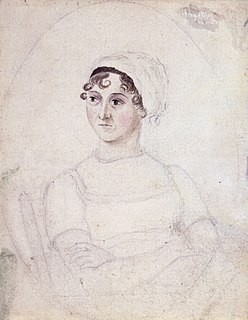
Jane Austen was an English novelist known primarily for her six major novels, which interpret, critique and comment upon the British landed gentry at the end of the 18th century. Austen's plots often explore the dependence of women on marriage in the pursuit of favourable social standing and economic security. Her works critique the novels of sensibility of the second half of the 18th century and are part of the transition to 19th-century literary realism. Her use of biting irony, along with her realism, humour, and social commentary, have long earned her acclaim among critics, scholars, and popular audiences alike.

Pride and Prejudice is a romantic novel of manners written by Jane Austen in 1813. The novel follows the character development of Elizabeth Bennet, the dynamic protagonist of the book who learns about the repercussions of hasty judgments and comes to appreciate the difference between superficial goodness and actual goodness. Its humour lies in its honest depiction of manners, education, marriage, and money during the Regency era in Great Britain.

Sense and Sensibility is a novel by Jane Austen, published in 1811. It was published anonymously; By A Lady appears on the title page where the author's name might have been. It tells the story of the Dashwood sisters, Elinor and Marianne as they come of age. They have an older half-brother, John, and a younger sister, Margaret, 13.
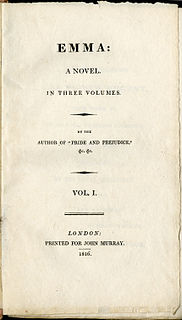
Emma, by Jane Austen, is a novel about youthful hubris and romantic misunderstandings. It is set in the fictional country village of Highbury and the surrounding estates of Hartfield, Randalls and Donwell Abbey, and involves the relationships among people from a small number of families. The novel was first published in December 1815, with its title page listing a publication date of 1816. As in her other novels, Austen explores the concerns and difficulties of genteel women living in Georgian–Regency England. Emma is a comedy of manners, and depicts issues of marriage, sex, age, and social status.

Persuasion is the last novel fully completed by Jane Austen. It was published at the end of 1817, six months after her death.
Sanditon (1817) is an unfinished novel by the English writer Jane Austen. In January 1817, Austen began work on a new novel she called The Brothers, later titled Sanditon, and completed eleven chapters before stopping work in mid-March 1817, probably because of her illness. R.W. Chapman first published a full transcription of the novel in 1925 under the name Fragment of a Novel.
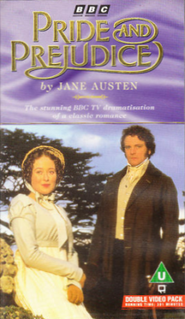
Pride and Prejudice is a six-episode 1995 British television drama, adapted by Andrew Davies from Jane Austen's 1813 novel of the same name. Jennifer Ehle and Colin Firth starred as Elizabeth Bennet and Mr Darcy respectively. Produced by Sue Birtwistle and directed by Simon Langton, the serial was a BBC production with additional funding from the American A&E Network. BBC1 originally broadcast the 55-minute episodes from 24 September to 29 October 1995. The A&E Network aired the series in double episodes on three consecutive nights beginning 14 January 1996.
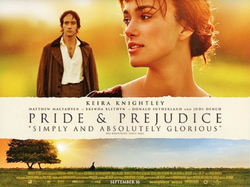
Pride & Prejudice is a 2005 romantic drama film directed by Joe Wright, in his feature directorial debut, and based on Jane Austen's 1813 novel of the same name. The film depicts five sisters from an English family of landed gentry as they deal with issues of marriage, morality and misconceptions. Keira Knightley stars in the lead role of Elizabeth Bennet, while Matthew Macfadyen plays her romantic interest Mr. Darcy. Produced by Working Title Films in association with StudioCanal, the film was released on 16 September 2005 in the United Kingdom and Ireland and on 11 November in the United States.
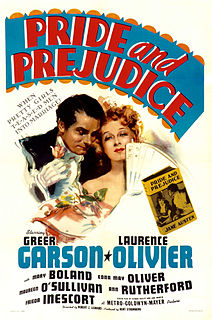
Pride and Prejudice is a 1940 American film adaptation of Jane Austen's 1813 novel Pride and Prejudice, directed by Robert Z. Leonard and starring Greer Garson and Laurence Olivier. The screenplay was written by Aldous Huxley and Jane Murfin, adapted specifically from the stage adaptation by Helen Jerome in addition to Jane Austen's novel. The film is about five sisters from an English family of landed gentry who must deal with issues of marriage, morality, and misconceptions. The film was released by MGM on July 26, 1940, in the United States and was critically well received. The New York Times film critic praised the film as "the most deliciously pert comedy of old manners, the most crisp and crackling satire in costume that we in this corner can remember ever having seen on the screen."
The Watsons is an abandoned novel by Jane Austen, probably begun about 1803. There have been a number of arguments advanced why she did not complete it and other authors have since attempted that task. Even before the manuscript fragment was eventually published in 1871, a continuation based on it by Austen's niece appeared in 1850. Further completions and adaptations of the story have continued to the present day.

Mr. Darcy's Daughters is a 2003 novel by the English author Elizabeth Aston, published by Simon & Schuster in the United States. Set in 1818, Mr. Darcy's Daughters is written as a sequel to Jane Austen's novel Pride and Prejudice. It features the five daughters of Fitzwilliam Darcy and Elizabeth Bennet – aged 21 to 16 – as they navigate London society in the absence of their parents, who have embarked on a diplomatic post to Constantinople. In London, the sisters meet new friends and find themselves in various romantic entanglements, all while learning what is acceptable behaviour among the city's elite.
Fitzwilliam Darcy, Gentleman is the collective name given to a trilogy of historical romance novels written by Pamela Aidan. As the title suggests, they are based heavily on Jane Austen's novel Pride and Prejudice, and feature many events of the novel as seen from the perspective of Mr. Fitzwilliam Darcy, the central male character of Austen's novel.
Belinda is an 1801 novel by the Irish writer Maria Edgeworth. It was first published in three volumes by Joseph Johnson of London, and was reprinted by Pandora Press in 1986. The novel was Edgeworth's second published, and was considered controversial in its day for its depiction of an interracial marriage.
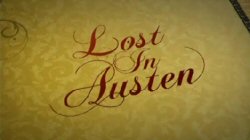
Lost in Austen is a four-part 2008 British television series for the ITV network, written by Guy Andrews as a fantasy adaptation of the 1813 novel Pride and Prejudice by Jane Austen. Amanda, a woman from modern London, enters the plot of the novel through a portal in her bathroom, to join the Bennet family and affect events disastrously.

Jane Austen's (1775–1817) distinctive literary style relies on a combination of parody, burlesque, irony, free indirect speech and a degree of realism. She uses parody and burlesque for comic effect and to critique the portrayal of women in 18th-century sentimental and gothic novels. Austen extends her critique by highlighting social hypocrisy through irony; she often creates an ironic tone through free indirect speech in which the thoughts and words of the characters mix with the voice of the narrator. The degree to which critics believe Austen's characters have psychological depth informs their views regarding her realism. While some scholars argue that Austen falls into a tradition of realism because of her finely executed portrayal of individual characters and her emphasis on "the everyday", others contend that her characters lack a depth of feeling compared with earlier works, and that this, combined with Austen's polemical tone, places her outside the realist tradition.
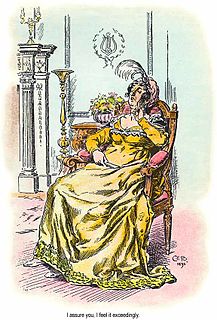
Lady Catherine de Bourgh is a character in the 1813 novel Pride and Prejudice by Jane Austen. According to Janet Todd, Lady Catherine can be seen as a foil to the novel's protagonist Elizabeth Bennet, who is seen as wild and contradict in her actions many of the ideals of a gentlewoman, while Lady Catherine is seen as strict to the rules of society.
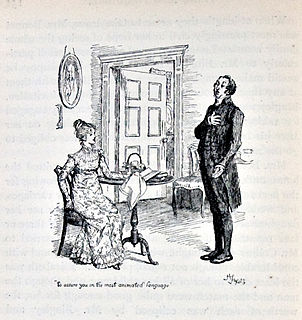
Mr William Collins is a fictional character in the 1813 novel Pride and Prejudice by Jane Austen. He is the distant cousin of Mr Bennet, a clergyman and holder of a valuable living at the Hunsford parsonage near Rosing's Park, the estate of his patroness Lady Catherine De Bourgh, in Kent. Since Mr and Mrs Bennet have no sons, Mr Collins is also the current heir presumptive to the Bennet's family estate of Longbourn House, in Meryton, Hertfordshire. Mr Collins is first introduced during his visit to Longbourn, Mr Bennet's estate. Mr. Collins is some-what comparable to the Shakespearean character, Malvolio, from Twelfth Night.

The Bennet family is a fictional family of dwindling Hertfordshire landed gentry, created by English novelist Jane Austen. The family plays a central role in Austen's 1813 novel Pride and Prejudice, as it is the protagonist, Elizabeth's family. The complex relationships between its various members influence the evolution of the plot.

Old Friends and New Fancies: An Imaginary Sequel to the Novels of Jane Austen (1913) is a novel by Sybil G. Brinton that is generally acknowledged to be the first sequel to the works of Jane Austen and as such the first piece of Austen fan fiction. It incorporates characters from each of Austen's six major novels into one unified story, alongside characters of Brinton's own invention. Keeping to the spirit of the source novels, its major theme is the difficulties faced by assorted pairs of lovers placed within the class structure of early 19th century Britain.
George Wickham is a fictional character created by Jane Austen who appears in her 1813 novel Pride and Prejudice. George Wickham is introduced as a militia officer who has a shared history with Mr. Darcy. Wickham's charming demeanour and his story of being badly treated by Darcy attracts the sympathy of the heroine, Elizabeth Bennet, to the point that she is warned by her aunt not to fall in love and marry him. It is revealed through the course of the story that George Wickham's true nature is that of a manipulative unprincipled layabout, a ne'er-do-well wastrel, compulsive liar and a degenerate, compulsive gambler, a seducer and a libertine, living the lifestyle of a rake. Lacking the finances to pay for his lifestyle, he gambles regularly and cons credit from tradesmen and shopkeepers and skips out on paying-up.
References
- ↑ M. Girouard, Enthusiasms (2011) Chap I
- ↑ E. Copeland ed., The Cambridge Companion to Jane Austen (1997) p. 85
- ↑ E. Copeland ed., The Cambridge Companion to Jane Austen (1997) p. 85
- ↑ M. Girouard, Enthusiasms (2011) Ch. I
- ↑ C. Tuite, Romantic Austen (Cambridge 2002) p. 32
- ↑ Quoted in B. Seeker, Jane Austen and Animals (2016) p. ix
- ↑ C. Tuite, Romantic Austen (Cambridge 2002) p. 40-1
- ↑ M. A Doody ed., Catherine and Other Writings (Oxford 1993) p. 202
- ↑ B. Seeker, Jane Austen and Animals (2016) p. 70